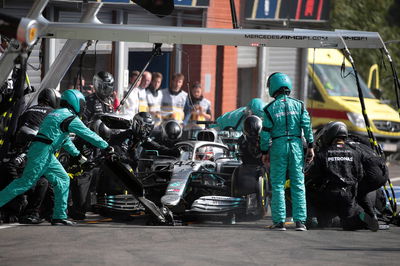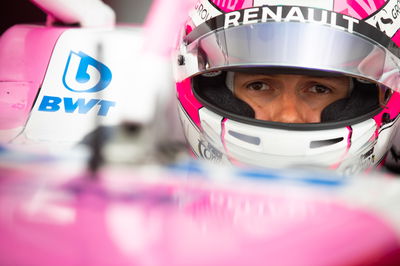Mercedes explains Hamilton’s pit stop time loss at Spa
Mercedes says it is working on “counter measures” after a wheel-nut problem resulted in a slow pit stop for Lewis Hamilton during Formula 1’s Belgian Grand Prix.
Hamilton’s stop was clocked at 3.6s, with Mercedes calculating that the Briton lost around a second in the pitlane as mechanics struggled to tighten the left-rear wheel on his W10 car having fitted a set of Medium tyres.

Mercedes says it is working on “counter measures” after a wheel-nut problem resulted in a slow pit stop for Lewis Hamilton during Formula 1’s Belgian Grand Prix.
Hamilton’s stop was clocked at 3.6s, with Mercedes calculating that the Briton lost around a second in the pitlane as mechanics struggled to tighten the left-rear wheel on his W10 car having fitted a set of Medium tyres.
The issue meant Hamilton had a bigger gap to reduce in his late pursuit for victory, but he ran out of laps to seriously challenge race-leader Charles Leclerc as the Ferrari driver held on to claim his maiden grand prix win by less than a second.
“We did have a slow stop with Lewis, it was with the rear-left wheel and the issue was actually getting the nut tight again on the wheel,” explained Mercedes trackside engineering director Andrew Shovlin.
“These problems are often not as simple as they seem but we do have quite a lot of data to look at, we’ve got video data from above the car during the pitstop, we’ve also got the data logging of the pit stop system itself and what we are doing is piecing through that to understand exactly what happened and make sure we can put counter measures in place for Monza.
“The loss was about a second or so, whether or not that would have had an impact on Lewis’ race again it’s really impossible to say but he did come out a bit further back and had to work the tyres a little bit harder to catch Leclerc, but you never know whether it would have been a significant factor.”
Shovlin said Mercedes felt it would have been well-positioned to win in Belgium had a stoppage for Carlos Sainz’s McLaren not resulted in a four-lap Safety Car period in the early stages.
“In Belgium we stopped Lewis the lap after Leclerc,” he added. “Now because Lewis was out on his older tyres, he lost a bit of time there, Leclerc was on fresh tyres and could build the gap while we stayed out on track, and that gave Lewis a bit more of a gap to close down.
“We came very close to getting into an overtaking position but the race was just a little too short for us. The big question was if we’d have gone one or two laps earlier, would we have been in a better position to overtake.
“Certainly we’d have been closer on track but our tyres were going off, as were Leclerc’s, we’d have had older tyres and a bit less performance. It’s a very difficult question to answer but always if what you tried didn’t work, you are always thinking you should have done something a bit differently.
The big factor was that if we didn’t have that Safety Car at the start, if the whole race had been four laps longer, that would have probably given us the distance, the time for his [Leclerc] tyres to degrade, that we could have perhaps made a move stick.”












